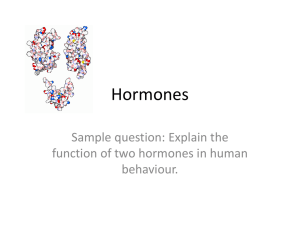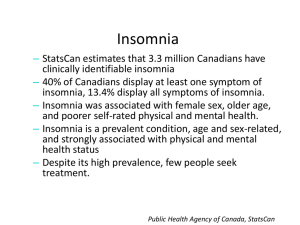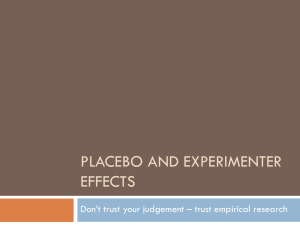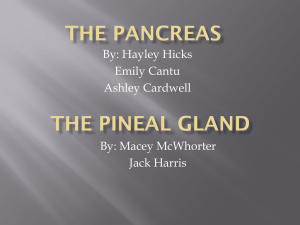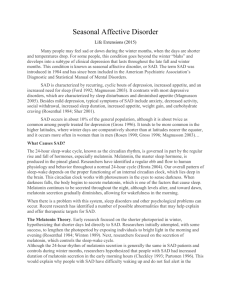Melatonin - Redemption Psychiatry
advertisement
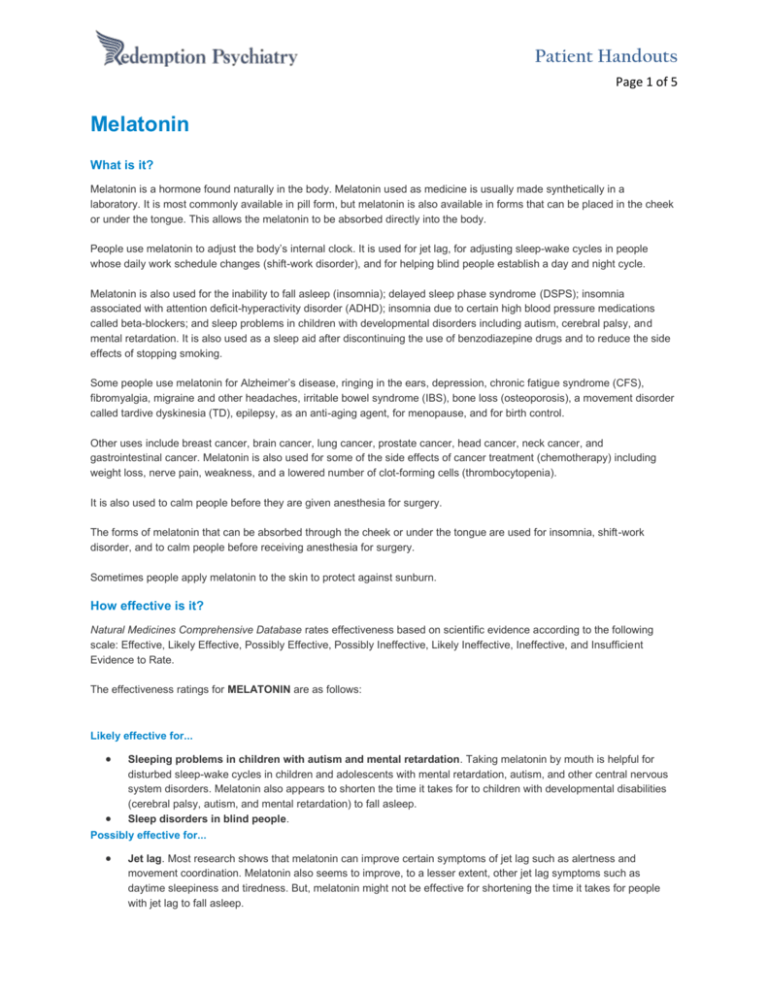
Patient Handouts Page 1 of 5 Melatonin What is it? Melatonin is a hormone found naturally in the body. Melatonin used as medicine is usually made synthetically in a laboratory. It is most commonly available in pill form, but melatonin is also available in forms that can be placed in the cheek or under the tongue. This allows the melatonin to be absorbed directly into the body. People use melatonin to adjust the body’s internal clock. It is used for jet lag, for adjusting sleep-wake cycles in people whose daily work schedule changes (shift-work disorder), and for helping blind people establish a day and night cycle. Melatonin is also used for the inability to fall asleep (insomnia); delayed sleep phase syndrome (DSPS); insomnia associated with attention deficit-hyperactivity disorder (ADHD); insomnia due to certain high blood pressure medications called beta-blockers; and sleep problems in children with developmental disorders including autism, cerebral palsy, and mental retardation. It is also used as a sleep aid after discontinuing the use of benzodiazepine drugs and to reduce the side effects of stopping smoking. Some people use melatonin for Alzheimer’s disease, ringing in the ears, depression, chronic fatigue syndrome (CFS), fibromyalgia, migraine and other headaches, irritable bowel syndrome (IBS), bone loss (osteoporosis), a movement disorder called tardive dyskinesia (TD), epilepsy, as an anti-aging agent, for menopause, and for birth control. Other uses include breast cancer, brain cancer, lung cancer, prostate cancer, head cancer, neck cancer, and gastrointestinal cancer. Melatonin is also used for some of the side effects of cancer treatment (chemotherapy) including weight loss, nerve pain, weakness, and a lowered number of clot-forming cells (thrombocytopenia). It is also used to calm people before they are given anesthesia for surgery. The forms of melatonin that can be absorbed through the cheek or under the tongue are used for insomnia, shift-work disorder, and to calm people before receiving anesthesia for surgery. Sometimes people apply melatonin to the skin to protect against sunburn. How effective is it? Natural Medicines Comprehensive Database rates effectiveness based on scientific evidence according to the following scale: Effective, Likely Effective, Possibly Effective, Possibly Ineffective, Likely Ineffective, Ineffective, and Insufficient Evidence to Rate. The effectiveness ratings for MELATONIN are as follows: Likely effective for... Sleeping problems in children with autism and mental retardation. Taking melatonin by mouth is helpful for disturbed sleep-wake cycles in children and adolescents with mental retardation, autism, and other central nervous system disorders. Melatonin also appears to shorten the time it takes for to children with developmental disabilities (cerebral palsy, autism, and mental retardation) to fall asleep. Sleep disorders in blind people. Possibly effective for... Jet lag. Most research shows that melatonin can improve certain symptoms of jet lag such as alertness and movement coordination. Melatonin also seems to improve, to a lesser extent, other jet lag symptoms such as daytime sleepiness and tiredness. But, melatonin might not be effective for shortening the time it takes for people with jet lag to fall asleep. Patient Handouts Page 2 of 5 Trouble sleeping (insomnia). Melatonin seems to be able to shorten the amount of time it takes to fall asleep, but only by about 12 minutes, according to one research study. Melatonin does not appear to significantly improve “sleep efficiency,” the percentage of time that a person actually spends sleeping during the time set aside for sleeping. Some people say melatonin makes them sleep better, even though tests don’t agree. There is some evidence that melatonin is more likely to help older people than younger people or children. This may be because older people have less melatonin in their bodies to start with. There is some interest in finding out whether melatonin might help with “secondary insomnia.” This is trouble sleeping that is related to other conditions such as Alzheimer’s disease; depression; schizophrenia; hospitalization; and “ICU syndrome,” sleep disturbances in the intensive care unit. Research to date suggests that melatonin might not help to reduce the time it takes to fall asleep in secondary insomnia, but it might improve sleep efficiency. Cluster headaches. Taking 10 mg of melatonin by mouth every evening might reduce the number of cluster headaches. However, taking 2 mg of melatonin at bedtime doesn’t seem to work. Reducing anxiety before surgery. Melatonin used under the tongue seems to be as effective in reducing anxiety before surgery as midazolam, a conventional medication. It also seems to have fewer side effects in some people. Helping elderly people sleep after they stop taking a type of drug called benzodiazepines. The controlledrelease form of melatonin is the type that was shown to work for this. Helping decrease symptoms in people who are quitting smoking. A single oral dose of 0.3 mg of melatonin taken 3.5 hours after stopping cigarettes seems to reduce anxiety, restlessness, irritability, depression, and cigarette craving over the next 10 hours. Low blood platelets (thrombocytopenia). Improving the effectiveness of certain cancer medications used to fight tumors in the breast, lung, kidney, liver, pancreas, stomach, colon, prostate, and decreasing some side effects of cancer treatment. Decreasing symptoms of a movement disorder called tardive dyskinesia (TD). Decreasing sunburn when applied to the skin in a cream form before going into the sun. Possibly ineffective for... Adjusting sleep schedule in people that do shift work. Likely ineffective for... Depression. There is also some concern that melatonin might worsen symptoms in some people. Insufficient evidence to rate effectiveness for... Epilepsy. There is some evidence that melatonin at bedtime may reduce the number and length of seizures in children with epilepsy. But melatonin should be used cautiously, because melatonin may increase the number of seizures in some people. Menopausal symptoms. Limited research suggests that melatonin does not relieve menopausal symptoms. However, melatonin in combination with soy isoflavones might help psychological symptoms associated with menopause. Sleep problems associated with attention deficit-hyperactivity disorder (ADHD). Limited research suggests melatonin might improve insomnia in children with ADHD who are taking stimulants. But improved sleep does not seem to decrease symptoms of ADHD. Migraine headache. There is some evidence that taking melatonin nightly before bed can prevent episodic migraine headache. When headaches do occur, they are milder and pass more quickly. Some research suggests that melatonin production might be altered in people with migraine. Insomnia caused by medications used for high blood pressure (beta-blockers). Headache characterized by sudden sharp pain (idiopathic stabbing headache). Ringing in the ears (tinnitus). Chronic fatigue syndrome (CFS). Osteoporosis. Irritable bowel syndrome (IBS). Birth control. Fibromyalgia. Aging. Other conditions. More evidence is needed to rate melatonin for these uses. Patient Handouts Page 3 of 5 How does it work? Melatonin’s main job in the body is to regulate night and day cycles or sleep-wake cycles. Darkness causes the body to produce more melatonin, which signals the body to prepare for sleep. Light decreases melatonin production and signals the body to prepare for being awake. Some people who have trouble sleeping have low levels of melatonin. It is thought that adding melatonin from supplements might help them sleep. Are there safety concerns? Melatonin is LIKELY SAFE for most adults when taken by mouth short-term or applied to the skin. It can cause some side effects including headache, short-term feelings of depression, daytime sleepiness, dizziness, stomach cramps, and irritability. Do not drive or use machinery for four to five hours after taking melatonin. Special precautions & warnings: Pregnancy and breast-feeding: Melatonin is POSSIBLY UNSAFE in pregnancy. Don’t use it. Melatonin might also interfere with ovulation, making it more difficult to become pregnant. Not enough is known about the safety of using melatonin when breast-feeding. It’s best not to use it. Children: Melatonin should not be used in most children. It is POSSIBLY UNSAFE. Because of its effects on other hormones, melatonin might interfere with development during adolescence. High blood pressure: Melatonin can raise blood pressure in people who are taking certain medications to control blood pressure. Avoid using it. Diabetes: Melatonin might increase blood sugar in people with diabetes. Monitor your blood sugar carefully, if you have diabetes and take melatonin. Depression: Melatonin can make symptoms of depression worse. Seizure disorders: Using melatonin might increase the risk of having a seizure. Are there interactions with medications? Major Do not take this combination. Sedative medications (CNS depressants) Melatonin might cause sleepiness and drowsiness. Medications that cause sleepiness are called sedatives. Taking melatonin along with sedative medications might cause too much sleepiness. Some sedative medications include clonazepam (Klonopin), lorazepam (Ativan), phenobarbital (Donnatal), zolpidem (Ambien), and others. Moderate Be cautious with this combination. Birth control pills (Contraceptive drugs) The body makes melatonin. Birth control pills seem to increase how much melatonin the body makes. Taking melatonin along with birth control pills might cause too much melatonin to be in the body. Some birth control pills include ethinyl estradiol and levonorgestrel (Triphasil), ethinyl estradiol and norethindrone (OrthoNovum 1/35, Ortho-Novum 7/7/7), and others. Caffeine Caffeine might decrease melatonin levels in the body. Taking melatonin along with caffeine might decrease the effectiveness of melatonin supplements. Patient Handouts Page 4 of 5 Fluvoxamine (Luvox) Taking fluvoxamine (Luvox) can increase the amount of melatonin that the body absorbs. Taking melatonin along with fluvoxamine (Luvox) might increase the effects and side effects of melatonin. Medications for diabetes (Antidiabetes drugs) Melatonin might increase blood sugar. Diabetes medications are used to lower blood sugar. By increasing blood sugar, melatonin might decrease the effectiveness of diabetes medications. Monitor your blood sugar closely. The dose of your diabetes medication might need to be changed. Some medications used for diabetes include glimepiride (Amaryl), glyburide (DiaBeta, Glynase PresTab, Micronase), insulin, pioglitazone (Actos), rosiglitazone (Avandia), chlorpropamide (Diabinese), glipizide (Glucotrol), tolbutamide (Orinase), and others. Medications that decrease the immune system (Immunosuppressants) Melatonin might increase the immune system. Taking melatonin along with medications that decrease the immune system might decrease the effectiveness of medications that decrease the immune system. Some medications that decrease the immune system include azathioprine (Imuran), basiliximab (Simulect), cyclosporine (Neoral, Sandimmune), daclizumab (Zenapax), muromonab-CD3 (OKT3, Orthoclone OKT3), mycophenolate (CellCept), tacrolimus (FK506, Prograf), sirolimus (Rapamune), prednisone (Deltasone, Orasone), corticosteroids (glucocorticoids), and others. Medications that slow blood clotting (Anticoagulant / Antiplatelet drugs) Melatonin might slow blood clotting. Taking melatonin along with medications that also slow clotting might increase the chances of bruising and bleeding. Some medications that slow blood clotting include aspirin, clopidogrel (Plavix), diclofenac (Voltaren, Cataflam, others), ibuprofen (Advil, Motrin, others), naproxen (Anaprox, Naprosyn, others), dalteparin (Fragmin), enoxaparin (Lovenox), heparin, warfarin (Coumadin), and others. Nifedipine GITS (Procardia XL) Nifedipine GITS (Procardia XL) is used to lower blood pressure. Taking melatonin might decrease the effectiveness of nifedipine GITS for lowering blood pressure. Sedative medications (Benzodiazepines) Melatonin might cause sleepiness and drowsiness. Drugs that cause sleepiness and drowsiness are called sedatives. Taking melatonin along with sedative medications might cause too much sleepiness. Some of these sedative medications include clonazepam (Klonopin), diazepam (Valium), lorazepam (Ativan), and others. Verapamil (Calan, Covera, Isoptin, Verelan) The body breaks down melatonin to get rid of it. Verapamil (Calan, Covera, Isoptin, Verelan) can increase how quickly the body gets rid of melatonin. Taking melatonin along with verapamil (Calan, Covera, Isoptin, Verelan) might decrease the effectiveness of melatonin. Minor Be watchful with this combination. Flumazenil (Romazicon) Flumazenil (Romazicon) might decrease the effects of melatonin. It is not yet clear why this interaction occurs. Taking flumazenil (Romazicon) along with melatonin might decrease the effectiveness of melatonin supplements. Patient Handouts Page 5 of 5 Are there interactions with herbs and supplements? Herbs and supplements that might slow blood clotting Melatonin might increase the effect of herbs that slow blood clotting and might increase the risk of bleeding in some people. These herbs include angelica, clove, danshen, garlic, ginger, ginkgo, Panax ginseng, red clover, willow, and others. Herbs and supplements with sleep-promoting (sedative) properties Using melatonin along with herbs that have sedative properties might increase the effects and side effects of melatonin. Some of these supplements include 5-HTP, calamus, California poppy, catnip, hops, Jamaican dogwood, kava, St. John's wort, skullcap, valerian, yerba mansa, and others. Are there interactions with foods? There are no known interactions with foods. What dose is used? The following doses have been studied in scientific research: BY MOUTH: For insomnia: 0.3-5 mg at bedtime is a typical dose. In children with insomnia due to delayed sleep onset, melatonin 5 mg at 6:00 PM daily. In children with developmental disorders (including cerebral palsy, autism, and mental retardation), melatonin 5 mg at 8:00 PM daily. Both immediate-release and sustained-release preparations have been used. For jet lag: 0.5-5 mg at bedtime is commonly taken on the arrival day at the destination, continuing for 2-5 days. Low doses of 0.5-3 mg are often used to avoid the hypnotic properties of the higher 4-5 mg doses. For tardive dyskinesia (TD): 10 mg daily of a controlled-release formulation. As treatment for solid tumors in combination with conventional therapy: 10-50 mg along with radiotherapy, chemotherapy, or interleukin 2 (IL-2). Melatonin is typically started 7 days before the start of chemotherapy and continued throughout full treatment course. For treatment of prostate cancer that has spread to other sites (metastatic cancer) and is resistant to triptorelin used alone: 20 mg taken daily has been used in combination with 3.75 mg of triptorelin injected into the muscle every 28 days. For prevention and treatment of lowered clot-forming cells (thrombocytopenia) associated with cancer chemotherapy: 20 mg each evening. For benzodiazepine withdrawal in elderly people with insomnia: 2 mg of controlled-release melatonin taken at bedtime for 6 weeks (the benzodiazepine dosage is reduced 50% during the second week, 75% during weeks 3 and 4, and stopped during weeks 5 and 6) and continued up to 6 months. For prevention of cluster headache: an evening dose of 10 mg. For reducing anxiety before surgery in adults: 0.05 mg/kg under the tongue. For reducing nicotine withdrawal symptoms: 0.3 mg orally 3.5 hours after stopping smoking. Other names MEL, Melatonina, Mélatonine, MLT, N-acetyl-5-methoxytryptamine, N-Acétyl-5-Méthoxytryptamine, Pineal Hormone.

